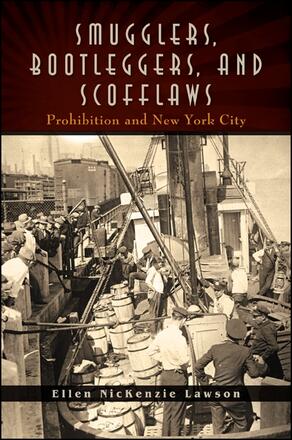
Smugglers, Bootleggers, and Scofflaws
Prohibition and New York City
Alternative formats available from:
Uses previously unstudied Coast Guard records for New York City and environs to examine the development of Rum Row and smuggling in New York City during Prohibition.
Description
With the passage of the Eighteenth Amendment, "drying up" New York City promised to be the greatest triumph of the proponents of Prohibition. Instead, the city remained the nation's greatest liquor market. Smugglers, Bootleggers, and Scofflaws focuses on liquor smuggling to tell the story of Prohibition in New York City. Using previously unstudied Coast Guard records from 1920 to 1933 for New York City and environs, Ellen NicKenzie Lawson examines the development of Rum Row and smuggling via the coasts of Long Island, the Long Island Sound, the Jersey shore, and along the Hudson and East Rivers. Lawson demonstrates how smuggling syndicates on the Lower East Side, the West Side, and Little Italy contributed to the emergence of the Broadway Mob. She also explores New York City's scofflaw population—patrons of thirty thousand speakeasies and five hundred nightclubs—as well as how politicians Fiorello La Guardia, James "Jimmy" Walker, Nicholas Murray Butler, Pauline Morton Sabin, and Al Smith articulated their views on Prohibition to the nation. Lawson argues that in their assertion of the freedom to drink alcohol for enjoyment, New York's smugglers, bootleggers, and scofflaws belong in the American tradition of defending liberty. The result was the historically unprecedented step of repeal of a constitutional amendment with passage of the Twenty-first Amendment in 1933.
Ellen NicKenzie Lawson is a retired professional historian and the editor of The Three Sarahs: Documents of Antebellum Black College Women (transcribed with Marlene D. Merrill). She lives in Loveland, Colorado.
Reviews
"This rich volume excels at storytelling. " — Long Island History Journal
"…Ellen NicKenzie Lawson mines a fantastic trove of little-used sources to detail the experience of Prohibition for three distinct but related groups of then-criminals in New York City … While the stories of swashbuckling smugglers and gangs of hoodlums make great fodder for popular entertainment, Lawson does a fine job of reconnecting their exploits to the longer and continuing narrative of popular resistance as a prominent feature of American life. " — Hudson River Valley Review
"Lawson offers an intriguing microcosm for the era as a whole in her examination of accounts of criminals, icons, and changing societal values, especially when compared to the more familiar battlegrounds of Chicago and the Canadian border. Rich with personalities and anecdotes, not to mention insight on the smuggling and prosecution sides of the Prohibition coin, Smugglers, Bootleggers, and Scofflaws adds deeper shading to an already colorful time period … a fascinating addition to Prohibition studies, casting a spotlight into a surprisingly under-researched corner of modern history. " — San Francisco Book Review
"…rollicking stories about America's attempt to 'dry up' the country. " — Chinook Observer
"Each autumn during Prohibition, it was not uncommon for the streets of Greenwich Village and Little Italy to run purple. This was due not to falling leaves or some Barney flash mob gone horribly wrong. It was 50,000 Manhattan residents supplementing their income by illegally making wine for the mob. This is just one of the many factoids crammed into Smugglers, Bootleggers, and Scofflaws. " — New York Post
"More than five thousand miles of coastline and only two hundred vessels to monitor smuggling activities—a situation ripe for creative and often humorous actions on both sides of the law! Mining Prohibition-era Coast Guard records at the National Archives, Ellen NicKenzie Lawson tells the story of how New York City, the greatest liquor market before Prohibition, retained its title. Cases of whiskey hidden under tons of freshly caught fish, smugglers masquerading as yachtsmen, law enforcement officials on the take, and the birth of the liquor smuggling syndicate are all documented in this impressive volume. Enlightening and entertaining. " — David S. Ferriero, Archivist of the United States, National Archives and Records Administration
"Smugglers, Bootleggers, and Scofflaws is a thorough and informative look at New York in the Prohibition era enlivened by new research in previously unexploited records. Fans of Boardwalk Empire will love it, while social and maritime historians will find much of interest. " — Ronald H. Spector, author of At War at Sea: Sailors and Naval Combat in the Twentieth Century
"Prohibition looms large in our national imagination. Yet, as Ellen Lawson has found, the central role of smuggling has been less studied. By mining National Archives records of vessels seized by the Coast Guard, Lawson gives us a vivid and fresh examination of the rum-running era in New York City's history. " — Field Horne, Chair (2001–2012), Conference on New York State History